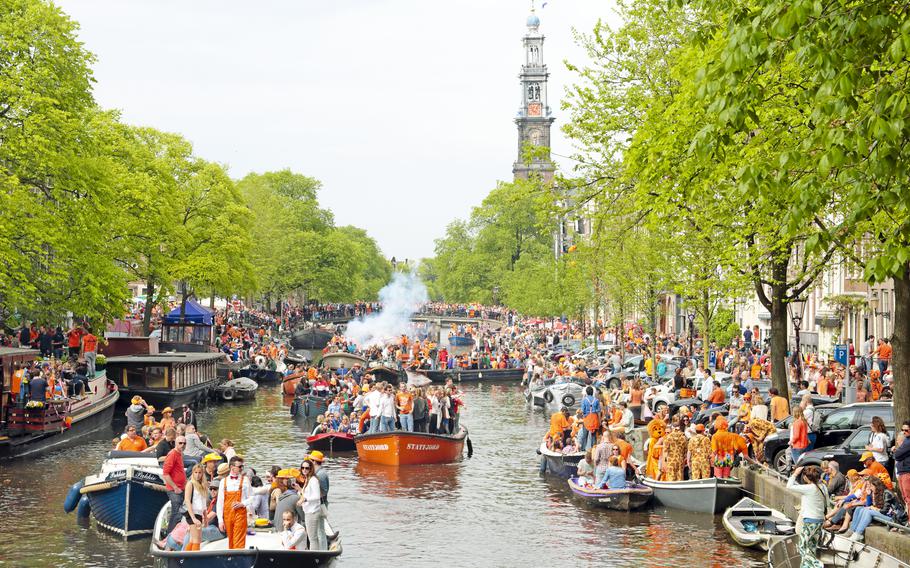
Amsterdam’s canals fill with revelers each King’s Day, April 27. Many places in the Netherlands will celebrate. (iStock)
Spring is here, and with it comes a slew of public holidays that signal it’s time to step outside and enjoy all the warmth and light our bodies have been craving. While most of Europe’s public holidays ostensibly commemorate dates with social or religious significance, a number of informal traditions have built themselves around these official days off.
King’s Day in Netherlands
On April 27, the birthday of King Willem-Alexander, King of the Netherlands since 2013, will be feted throughout the land with street parties, concerts, fun fairs and flea markets. Many cities and towns have their own particular customs to mark “Koningsdag.”
Informal flea markets pop up in parks, riverbanks and city sidewalks. The city of Utrecht marks King’s day with its legendary “Vrijmarkt,” which occupies much of the city center from Vredenburg to the Wijde Begijnhof. The market kicks off the evening before and continues until 6 p.m. the next day. Plenty of free live music and DJ sets will rock Utrecht’s biggest squares, including the one in front of the cathedral. Online: koningsdaginutrecht.nl
The Hague has long been known as the place to party down on King’s Day. The fun starts on the night before with “The Life I Live,” a huge free outdoor music festival encompassing genres from punk to pop. Eight stages transform the city center into a huge party zone with acts ranging from local bands to internationally known names. The event runs from 7 p.m. to 1 a.m. the following day. Online: thelifeilive.nl/about-2-2
On King’s Day itself, The Hague’s Zuiderpark hosts “Kingsworld,” a music fest spread over three zones including a main stage and a space dedicated to music of the 1990s. The event is for those over 18 only; tickets cost 40.85 euros ($44.55). Online: kingsworlddenhaag.nl
While Amsterdam is considered another great place to party, the officially organized activities take place outside the city center and music festivals are mostly ticketed affairs. This is in order to prevent overcrowding, which is pretty much guaranteed in any event. An informal vibe prevails as hordes of revelers roam the streets and buskers and street artists strut their stuff. Those with access to a watercraft take their partying to the chock-full canals. One area that does offer free and organized activities is the NDSM Vrijhaven, where a flea market offering children’s wares will be set up. Another children’s flea market will take place in the Vondelpark.
The king and royal family usually pay a visit to a different city each year, and in 2023, King Willem-Alexander and Queen Maxima are set to attend the festivities in Rotterdam. The official itinerary begins at the Afrikaanderplein at 11 a.m. and moves slowly along a kilometer-long route punctuated by dance shows, circus acts and a block party.
Tourists are more than welcome to take part in the festivities, and they’ll no doubt have fun emulating the locals. They can do so by toasting to the king’s good health with a brightly colored orange bitter, and snack on a tompouce, a cream-filled pastry lashed with orange icing. To really blend in, they should wear something orange. This is the color of the Dutch royal family, whose lineage traces back to the House of Orange.
May Day
In many countries, May 1 is a public holiday commemorating labor and the rights of the working classes. Known variously as Labor Day or International Worker’s Day, the day coincides with May Day, a deep-rooted festival held to mark the beginning of the summer season. Rituals carried out at this special time of year ranged from weaving wreaths or garlands of flowers to erecting and dancing around maypoles. A closely related tradition is that of Walpurgis Night, celebrated on the night of April 30. This feast commemorates the canonization of Saint Walpurga, an 8th century female saint called upon for protection against plagues, rabies and witchcraft. Celebrations can take many forms.
In the Czech Republic, it’s a night for burning witches, with huge bonfires lit up on top of hills. After burning witch effigies, the flames are put to use for roasting sausages and the beer flows freely. In Finland, the celebratory beverages of choice include sparkling wine and simi, a drink made of fermented honey or sugar water. Sweden celebrates with massive bonfires and performances by local choirs. The Skansen open air museum in Stockholm hosts what’s billed as the country’s largest Walpurgis celebrations. In Germany, it’s traditional to Tanz in den Mai, or dance into May, with parties held in venues ranging from parks to pubs to dance clubs.
The Gaelic version of May Day festivities is known as Beltane, observed primarily in Ireland, Scotland and the Isle of Man. Ancient traditions have been revived in Edinburgh, where the Beltane Fire Festival takes place on Calton Hill. A procession winds its way from the National Monument, led by the May Queen and the Green Man. Atop the hill, a stage performance signifying the inception of summer is followed by the lighting of a huge bonfire and ritual dancing. Acrobatics, drummers, musicians and other performers add to the scene. Adult tickets sell online at a cost of 16.38 UK pounds, or about $20.40. Tickets for children under age 16 go for 7.80 pounds each. Online: beltane.org
Ascension Day
On Thursday, May 18, the Christian holiday of Ascension commemorates Jesus’ ascension to heaven 40 days after Easter. Throughout Germany, the day informally known as Vatertag, or Father’s Day, gives the country's male population all the pretext needed to meet up with friends and party down. Typical activities on the day include hiking through the forest with a wagon full of beers in tow or visiting a beer garden.